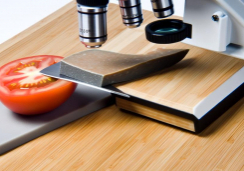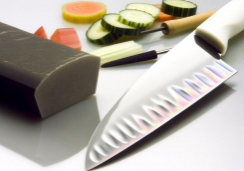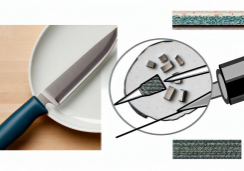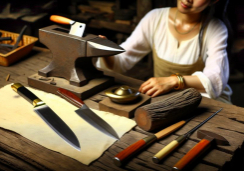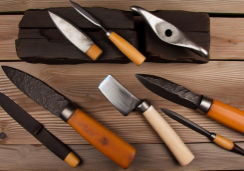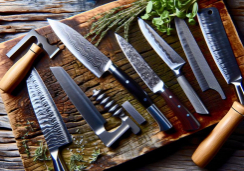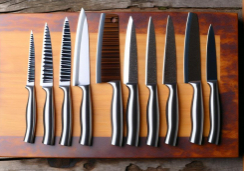What Keeps Ceramic Kitchen Blades Razor-Sharp?
Did you know that ceramic blades can retain their edge up to ten times longer than their steel counterparts? You've likely invested in one, attracted by the promise of enduring sharpness that makes slicing and dicing a breeze.
Yet, you might wonder what secret lies within these sleek, white blades that enable them to withstand the rigors of your cutting board day after day. It's not just about the material itself, but also the precise engineering that goes into crafting each knife.
As you handle your own ceramic blade, consider the intricate balance of hardness and brittleness, and the meticulous process that ensures its edge remains nearly as sharp as the day you first used it.
Stick around, and you'll uncover the scientific principles and practical tips that preserve the keen edge of these modern kitchen marvels.
Composition of Ceramic Blades
Ceramic blades are crafted from zirconium dioxide, also known as zirconia, which undergoes a complex sintering process to achieve its exceptional hardness and edge retention. This synthetic material rivals the toughness of diamonds, ranking 8.5 on the Mohs scale of mineral hardness, making your ceramic blade incredibly wear-resistant and less prone to dulling than traditional steel counterparts.
You'll appreciate that zirconia's crystalline structure contributes to the blade's sharpness. During sintering, the zirconia powder is exposed to high temperatures and pressures, causing the crystals to fuse without melting fully. This process, called solid-state sintering, consolidates the material into a very dense form, eliminating pores and creating a uniform microstructure.
The resulting blade offers you a chemically nonreactive edge that won't rust or discolor. It's impervious to acids and caustic substances found in some foods, ensuring that it won't transfer metallic tastes or smells and will maintain its pristine whiteness over time.
Your ceramic blade's durability stems from its refined composition and the meticulous manufacturing process. The edge, often honed to a microscopic precision, can sustain its razor-sharpness for months, or even years, without the need for frequent sharpening. This makes it a reliable tool for precision cutting tasks in your kitchen.
Manufacturing Process Explained
Understanding the exceptional hardness and edge retention of ceramic blades leads us to examine their meticulous manufacturing process. The creation of these blades isn't simple; it requires precision and a series of carefully controlled steps. Here's what you need to know:
- Raw Material Preparation
- Zirconium oxide powder is the primary ingredient, known for its durability.
- Various binders and sintering aids are added to enhance the blade's properties.
- The mixture is homogenized to ensure uniformity.
- Forming and Shaping
- The powder is pressed into a blade shape using a die.
- Pressure applied can be uniaxial or isostatic, affecting the density.
- The formed blade undergoes machining to define its basic geometry.
- Edges are precision ground to initiate sharpness.
- Grinding wheels are often diamond coated for accuracy.
- Sintering Process
- The blade is sintered in a high-temperature kiln.
- Temperatures reach up to 1,400°C, inducing particle fusion.
- The process densifies the material and eliminates porosity.
- A secondary hot isostatic pressing (HIP) may follow to further enhance density.
Each step is crucial; even minor deviations can lead to imperfections. Consequently, rigorous quality control measures accompany the entire process, ensuring that you'll handle a blade that meets the high standards expected from ceramic cutlery.
Proper Usage and Handling
To ensure the longevity and performance of your ceramic kitchen blade, it's essential to master proper usage and handling techniques. Unlike metal knives, ceramic blades are crafted from zirconium oxide, a material that boasts remarkable hardness. This hardness, however, also renders the blades more brittle. Therefore, you must use them exclusively for slicing or dicing fruits, vegetables, and boneless meats. Any action that involves twisting or prying can lead to chipping or even breaking of the blade.
Avoid cutting on surfaces like stone, glass, or metal, as these can dull the sharp edge. Instead, opt for a wooden or plastic cutting board that's gentler on the ceramic. When washing, do so by hand with mild detergent and avoid the dishwasher where high temperatures and harsh chemicals can degrade the blade. Store the knife in a block, sheath, or a designated area where it won't come into contact with other utensils.
Sharpening a ceramic knife requires specialized diamond dust-coated tools due to its hardness. It's recommended to have it professionally sharpened or use the appropriate sharpening tools with caution.
Cleaning and Storage Techniques
After mastering the use of your ceramic kitchen blade, it's crucial to apply meticulous cleaning and storage techniques to further protect its integrity. Ceramic blades demand a level of care that maintains their pristine condition and unparalleled sharpness. Here's how you can ensure longevity and performance:
- Cleaning
- Hand wash with warm water and a mild detergent; avoid harsh abrasives.
- Rinse thoroughly to prevent residue build-up, which can degrade the blade.
- Dry immediately with a soft cloth; water spots can indicate mineral deposits that may affect the blade's surface.
- Storage
- Utilize a knife block or sheath; direct contact with other utensils can cause chipping.
- Knife blocks should have horizontal slots to minimize edge contact.
- Sheaths must be soft-lined to avoid scratching the blade.
- Keep the knife in a consistent, secure location away from high-traffic areas to prevent accidental drops or impacts.
- Maintenance
- Inspect the blade regularly for any signs of damage or dullness.
- Sharpen only with tools designed for ceramic; traditional steel honing methods are unsuitable.
- If chipping occurs, seek professional restoration to restore the blade's edge without compromising its structural integrity.
Adhering to these guidelines ensures that your ceramic kitchen blade remains a sharp and reliable tool in your culinary arsenal.
Honing and Sharpening Tips
Maintaining your ceramic kitchen blade's edge requires specific sharpening methods, as conventional steel-based techniques can damage its delicate material. Unlike metal knives, ceramic blades don't need frequent honing. They stay sharp for extended periods due to their hard, wear-resistant material. When they do dull, you'll need a diamond-dust sharpener, the only effective solution for the high-hardness ceramic.
You should employ a controlled, gentle pressure while sharpening. Excessive force can lead to chipping or cracking your ceramic blade. Begin by placing the sharpener on a stable surface. Hold the knife at the correct angle – typically a 20-degree angle is optimal for ceramic knives. Carefully draw the blade through the sharpener, ensuring consistent contact and angle throughout the stroke. Repeat this process several times, checking the blade's sharpness periodically.
Avoid using a traditional honing rod, as this can cause damage. If you're uncomfortable sharpening the ceramic blade yourself or encounter significant dullness, consider professional resharpening services. They possess the know-how and specialized equipment to restore the edge without compromising the blade's integrity.
How Can I Maintain the Sharpness of Ceramic Kitchen Blades?
Maintaining the sharpness of ceramic kitchen blades is essential for efficient cooking. To keep them in top condition, invest in a good quality knife sharpener and sharpen the blades regularly. Avoid cutting on hard surfaces, and hand wash and dry the blades immediately after use. These tips for sharp kitchen blades will help prolong their lifespan.
Conclusion
In conclusion, your ceramic kitchen blades maintain their razor-sharp edge due to their hard zirconium oxide composition and precision manufacturing process.
By using them correctly, avoiding hard surfaces, and employing proper cleaning and storage protocols, you ensure minimal wear.
Honing isn't typically necessary, but if sharpening is required, it must be done with specialized tools.
Adhering to these practices will keep your ceramic blades in peak condition, ensuring precise and consistent cutting performance.

